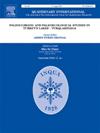Late Quaternary fluvio-aeolian interactions and possible aridification in west-central India: Implications for prehistoric human adaptations in the Central Tapi Valley
IF 1.8
3区 地球科学
Q3 GEOGRAPHY, PHYSICAL
引用次数: 0
Abstract
The Central Tapi Valley in India presents a unique opportunity to study Late Quaternary environmental changes, with a particular focus on fluvio-aeolian interactions, aridification, and their implications for human adaptation. To reconstruct the sedimentary history, we used a multi-proxy approach using microstructural analysis of quartz grains, grain size distribution and magnetic susceptibility. Our findings reveal a two-phase depositional process: fluvial processes dominate the upper layers (Phase 1), while aeolian influences characterize the lower layers (Phase 2), suggesting seasonal wind variations and episodic aridification in the region. In the magnetic susceptibility data, Phase 1 is characterized by ferrimagnetic minerals linked to increased pedogenesis and intensified Indian Summer Monsoon activity, and Phase 2, dominated by antiferromagnetic minerals, is indicative of aeolian processes and drier conditions. These findings underscore the broader patterns of intercontinental aridification, extending into central India and influencing human habitation and adaptation strategies during this period. Hence, this study contributes to the understanding of the Late Quaternary landscape transformations and provides valuable insights into how climate variability and environmental stressors shaped human adaptation in West-Central India, and demonstrates the potential to enhance the understanding of intercontinental aridification and dustiness in central India, reaching beyond the Himalayan and Thar Desert zones.
印度中西部晚第四纪河流-风成相互作用和可能的干旱化:对史前人类在中部塔皮河谷适应的影响
印度中部塔皮河谷为研究晚第四纪环境变化提供了一个独特的机会,特别关注河流-风沙相互作用、干旱化及其对人类适应的影响。为了重建沉积历史,我们采用了多代理方法,分析了石英颗粒的微观结构、粒度分布和磁化率。我们的研究结果揭示了一个两阶段的沉积过程:河流作用主导上层(阶段1),而风沙影响表征下层(阶段2),表明该地区的季节性风变化和幕式干旱化。在磁化率资料中,第1阶段以铁磁性矿物为主,与土壤作用增强和印度夏季风活动增强有关;第2阶段以反铁磁性矿物为主,表明风成过程和干燥条件。这些发现强调了更广泛的洲际干旱化模式,延伸到印度中部,并影响了这一时期的人类居住和适应策略。因此,本研究有助于理解晚第四纪景观转变,并为气候变率和环境压力因素如何影响印度中西部人类适应提供了有价值的见解,并展示了加强对印度中部洲际干旱化和粉尘的理解的潜力,超出了喜马拉雅和塔尔沙漠地带。
本文章由计算机程序翻译,如有差异,请以英文原文为准。
求助全文
约1分钟内获得全文
求助全文
来源期刊

Quaternary International
地学-地球科学综合
CiteScore
5.60
自引率
4.50%
发文量
336
审稿时长
3 months
期刊介绍:
Quaternary International is the official journal of the International Union for Quaternary Research. The objectives are to publish a high quality scientific journal under the auspices of the premier Quaternary association that reflects the interdisciplinary nature of INQUA and records recent advances in Quaternary science that appeal to a wide audience.
This series will encompass all the full spectrum of the physical and natural sciences that are commonly employed in solving Quaternary problems. The policy is to publish peer refereed collected research papers from symposia, workshops and meetings sponsored by INQUA. In addition, other organizations may request publication of their collected works pertaining to the Quaternary.
 求助内容:
求助内容: 应助结果提醒方式:
应助结果提醒方式:


